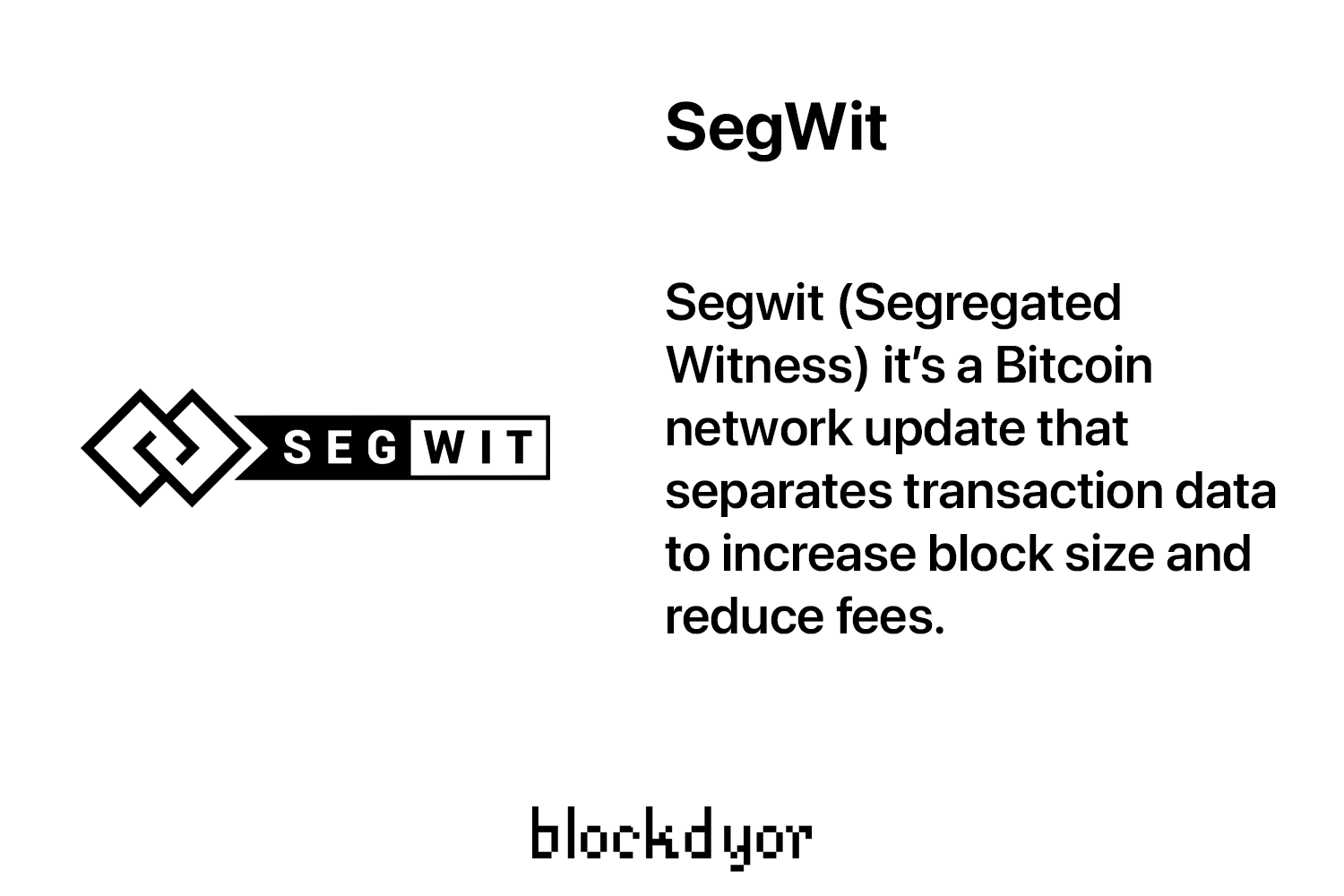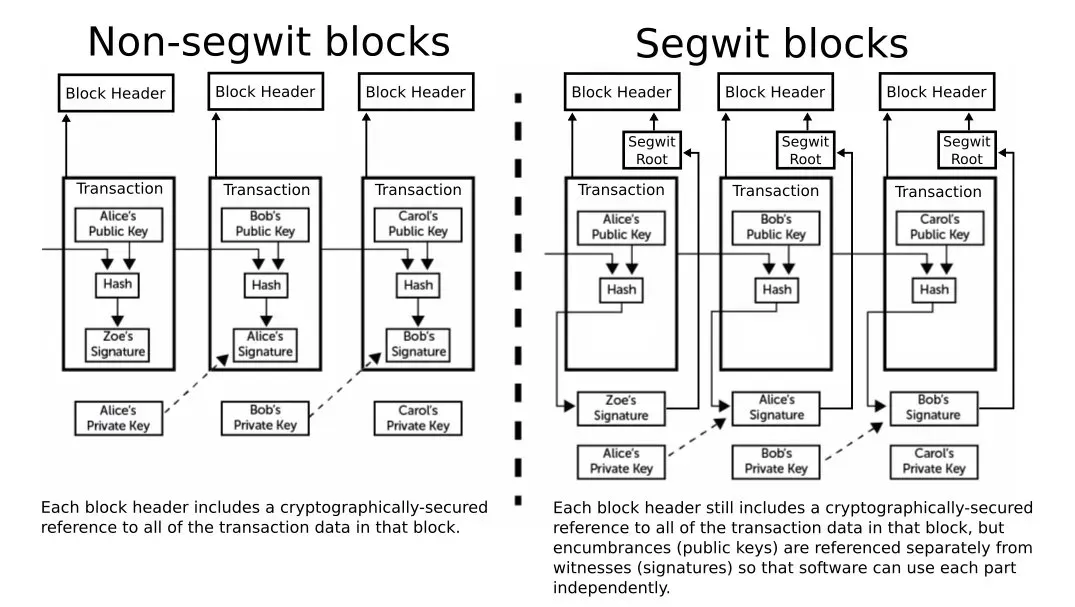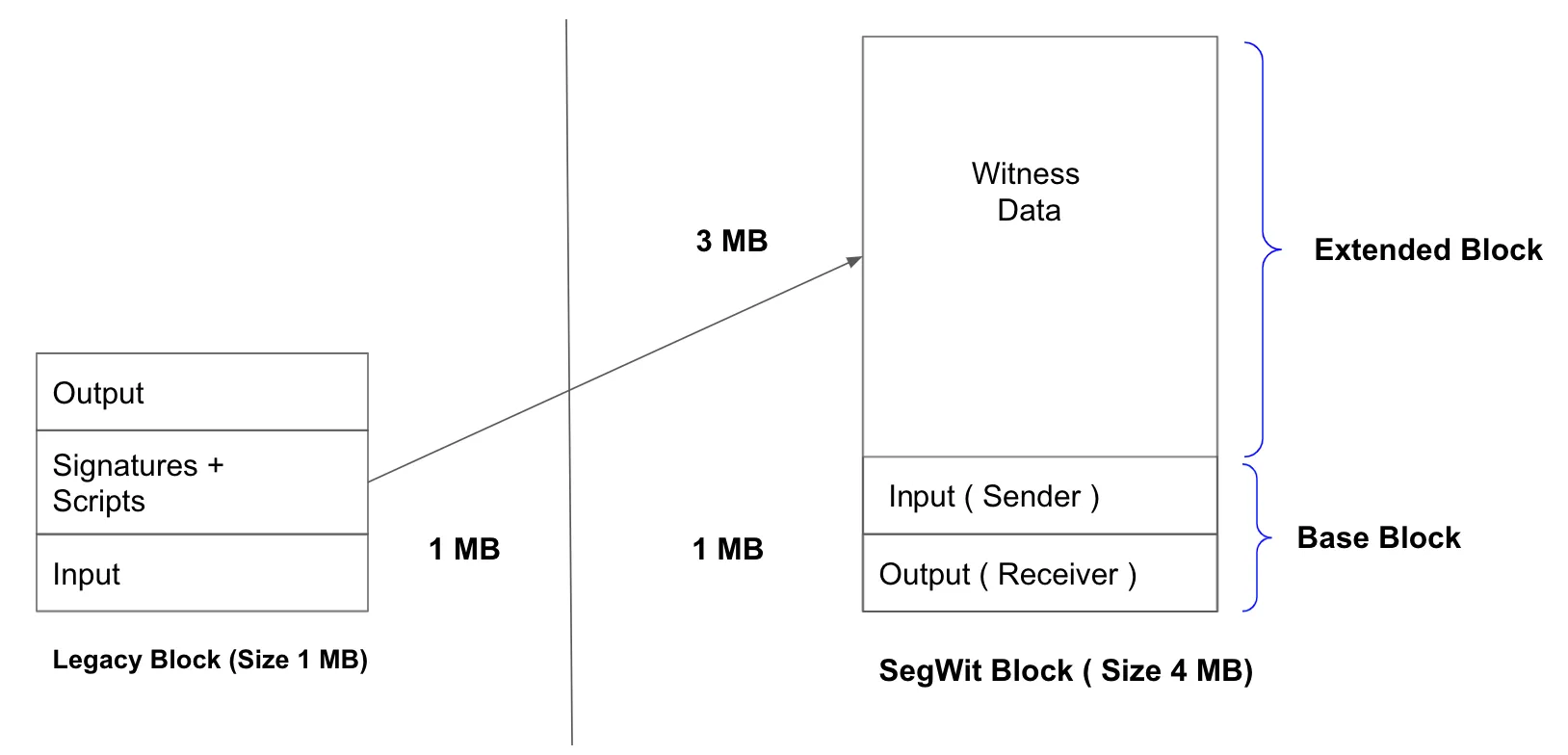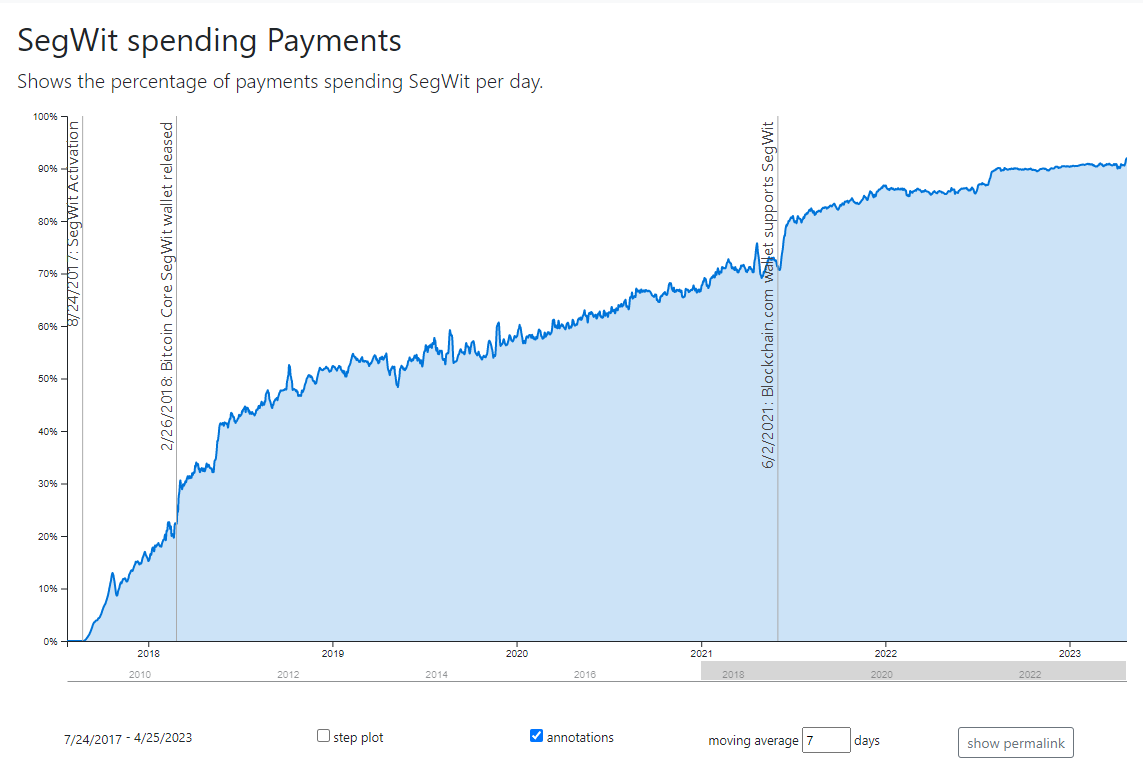Segregated Witness (SegWit): What Is It And How Does It Work?
In this guide, we will analyze SegWit's benefits, drawbacks, and implementation process. We will explore what is Segwit, how SegWit works, its impact on transaction fees, and its potential for future Bitcoin protocol improvements.
What Is Segregated Witness (SegWit)?
The term Segregated Witness (SegWit) refers to a change in the transaction format of Bitcoin, which was first proposed in 2015 (BIP 141) and activated on the Bitcoin network in August 2017.
SegWit is an upgrade to the Bitcoin protocol that addresses several issues related to transaction malleability, block size limit, and the potential for transaction replay attacks.
One of the intentions of this update, was for the validation process, by storing more transactions inside a block.
| Description | Details |
|---|---|
| 📝 BIP Number | 141 |
| 🤝 Type of BIP | Consensus (soft fork) |
| 📜 Name/Description | Segregated Witness (Consensus layer) |
| 👥 Authors | Eric Lombrozo, Johnson Lau, Pieter Wuille |
| 🏷️ Type | Standard |
| 🏁 Status | Final |
Segregated Witness (Segwit): How Does It Work?

SegWit works by separating the transaction signature data, or "witness" data, from the transaction data itself. This means that the witness data no longer counts towards the block size limit, which is set at 1 megabyte (MB) in the original Bitcoin protocol. By doing this, SegWit increases the effective block size limit to up to 4 MB, depending on the type of transactions being included.
Segwit also introduces a new transaction ID scheme that is immune to transaction malleability, a vulnerability in the Bitcoin protocol that allowed for the modification of transaction IDs, which could lead to double-spending attacks. With Segwit, the transaction ID is calculated based on the transaction data only, without including the witness data, making it resistant to tampering.
In addition, Segwit provides a way to implement the Lightning Network, a layer-2 scaling solution for Bitcoin that enables near-instant and low-cost transactions without the need for on-chain confirmation. The Lightning Network uses Segwit's transaction malleability fix and transaction script enhancements to create a network of payment channels between users, where transactions are settled off-chain and later broadcasted to the Bitcoin network.
To start using SegWit, Bitcoin users need to upgrade their wallet software to support Segwit transactions. Segwit addresses start with the letter "bc1" instead of the traditional "1" or "3" addresses, which indicates that they are Segwit-compatible. Segwit transactions offer several benefits over traditional transactions, including lower fees, faster confirmation times, and improved security.
Differences between Witness Data and Transaction Data
Segregated Witness (SegWit) introduces a new transaction structure in Bitcoin that consists of two parts: the transaction data and the witness (signature) data. The transaction data contains information about the sender, receiver, and the amount being sent, among other details. The witness data, on the other hand, includes the digital signatures required to validate the transaction.
Before SegWit, the witness data was included in the same block as the transaction data, taking up a significant amount of block space. With SegWit, the witness data is separated from the transaction data, allowing it to be stored in a separate "witness block" that is not counted towards the block size limit.
This separation of transaction data and witness data has several benefits, including increased transaction capacity and improved security. By reducing the amount of data that needs to be included in each block, SegWit increases the number of transactions that can be processed in each block. Additionally, separating the witness data from the transaction data makes it more difficult for attackers to manipulate transactions by altering the signature data.
Benefits of Adopting Segregated Witness (SegWit)
SegWit has several advantages for the Bitcoin network and its users. Here you can find some of the key advantages of adopting SegWit:
Increased transaction capacity
SegWit achieves a reduction in the size of each transaction by isolating the witness data from the transaction data. This leads to an increase in block capacity, allowing for a higher transaction throughput, and ultimately enabling the Bitcoin network to process more transactions at any given time.
Improved transaction security
By separating the witness data from the transaction data, SegWit addresses the transaction malleability issue and enhances the security of Bitcoin transactions. This prevents attackers from manipulating the transaction by altering signature data, making it harder for them to carry out malicious activities such as double-spending attacks.
Lower transaction fees
SegWit's increased transaction capacity leads to lower transaction fees by reducing competition among transactions. By minimizing the amount of data that needs to be processed and included in each block, SegWit lowers the cost of transaction processing and, as a result, reduces fees for users.
Backwards compatibility with existing software
SegWit is backwards-compatible with existing Bitcoin software, allowing users to continue using their current wallets and other applications without requiring a SegWit-compatible upgrade. This seamless transition to the new technology minimizes disruption for users and businesses on the Bitcoin network.
How Segregated Witness (SegWit) Addresses Transaction Malleability
In Bitcoin, a transaction malleability issue arises when the digital signature of a transaction is altered without changing the underlying transaction's validity. This creates a problem for some Bitcoin applications, such as those relying on unconfirmed transactions or multisignature transactions.
For example, if a transaction's signature is modified, its transaction ID (TXID) will also change. If an application relies on the original TXID, it will fail to detect the transaction's confirmation or recognize that it has been included in a block. This can cause problems for exchanges, wallets, and other services that rely on transaction tracking.
To address this issue, Bitcoin introduced Segregated Witness (SegWit). As we have seen, SegWit separates transaction data from signature data by moving the signature data to a separate structure called the witness. This allows the signature data to be stripped away from the transaction data when it is broadcasted across the network, reducing the amount of data that needs to be transmitted.
By separating the signature data from the transaction data, SegWit fixes the transaction malleability issue by removing the ability to modify signatures without changing the transaction's ID. This creates a more robust and secure system for Bitcoin transactions, as it reduces the risk of fraud and increases the reliability of Bitcoin applications.
Implementing SegWit: How It Affects Bitcoin Transactions
Segregated Witness (SegWit) adoption affects Bitcoin transactions by changing the way transaction data is stored in a block. The implementation of SegWit separates the signature data from the transaction data, enabling more efficient use of block space and improving the scalability and security of the Bitcoin network.
In a traditional Bitcoin transaction, the signature data is stored alongside the transaction data, resulting in a larger block size. With SegWit, the signature data is moved to a separate block, known as the witness block, which is attached to the original transaction. This results in smaller transaction sizes and frees up space in each block, allowing more transactions to be included in each block.
One significant benefit of SegWit adoption is that it can help reduce transaction fees. With smaller transaction sizes, the amount of data transmitted across the network is reduced, leading to lower fees. This is particularly important during periods of high network congestion when transaction fees can rise considerably.
Another advantage of SegWit adoption is that it allows for the implementation of second-layer solutions such as the Lightning Network. This is a payment protocol built on top of the Bitcoin network that allows for near-instant and low-cost transactions. The implementation of SegWit enables the use of the Lightning Network, which can facilitate micropayments and improve the overall efficiency of the Bitcoin network.
Compared to legacy Bitcoin transactions, SegWit transactions have several advantages. First, SegWit transactions are smaller in size, allowing more transactions to be included in a block. This reduces the overall transaction fees and improves the scalability of the Bitcoin network. Second, SegWit transactions are more secure, as they reduce the risk of transaction malleability and enable the implementation of advanced security features. Finally, SegWit transactions are compatible with legacy Bitcoin transactions, meaning that they can be sent and received by users who have not yet upgraded to SegWit.
Exploring the Technical Aspects of Segregated Witness (SegWit)

To understand the technical aspects of SegWit, it's essential to understand some of the key concepts, including block size limits and witness commitment structures.
- Block Size Limits: The Bitcoin network has a fixed block size limit of 1 MB. This means that each block can only contain up to 1 MB of data, which limits the number of transactions that can be processed in each block. SegWit increases the effective block size limit by moving the signature data to a separate block, allowing for more transaction data to be included in each block.
- Witness Commitment Structures: The SegWit implementation introduces a new concept called a witness commitment structure. This structure is included in the block header and is used to commit to the witness data associated with each transaction. This commitment allows nodes to verify the integrity of the witness data and ensures that it hasn't been tampered with.
- The witness commitment structure includes a Merkle tree that hashes all of the witness data for each transaction. The root of this Merkle tree is then included in the coinbase transaction, which is the first transaction in each block. By including the root of the Merkle tree in the coinbase transaction, the network can verify that the witness data for each transaction is valid and hasn't been modified.
- Transaction ID and Witness Data: With the implementation of SegWit, the transaction ID (TXID) of a transaction no longer includes the witness data. Instead, a new TXID is generated that includes only the transaction data. This ensures that the TXID remains consistent even if the witness data is modified. This change also allows nodes to track transactions more easily and enables the implementation of advanced features such as transaction batching and fee bumping.

Basically, the technical implementation of Segregated Witness (SegWit) involves several changes to the Bitcoin protocol, including the separation of the witness data from the transaction data, the use of witness commitment structures, and the generation of a new transaction ID that excludes the witness data.
These changes increase the effective block size limit, improve the security and efficiency of the network, and enable the implementation of advanced features such as LN (Lightning Network, the Bitcoin second-layer).
Segregated Witness (SegWit): The Future of Bitcoin?
Segregated Witness has the potential to significantly impact the future of Bitcoin by addressing some of the key challenges facing the network, such as scalability and security.
By separating the signature data from the transaction data, SegWit enables more efficient use of block space, reduces transaction fees, and improves the overall efficiency of the network. Additionally, SegWit opens the door to the implementation of second-layer solutions, such as the Lightning Network, which can facilitate micropayments and improve the overall user experience.

The adoption of SegWit has already had a significant impact on the Bitcoin network and continues to still have it, to this day. Ever since its implementation in August 2017, the proportion of SegWit transactions has been steadily increasing. Today, over 80% of Bitcoin transactions use SegWit.
What's even more interesting is that the adoption of SegWit has led to an increase in adoption and a reduction in transaction fees, as well as improved network efficiency. This clearly demonstrates the potential impact that SegWit can have on the future of Bitcoin.
Looking forward, it's likely that SegWit will continue to play an important role in the ongoing evolution of the Bitcoin network. Thanks to its implementation, new applications and use cases like Lightning have become possible, which were not feasible before. And as more users adopt SegWit, these applications are likely to become more widely used, leading to further innovation and development.
Of course, there are still some potential obstacles facing the future of SegWit adoption. One such obstacle is the need for backward compatibility with legacy Bitcoin transactions. While SegWit transactions are fully compatible with legacy transactions, not all Bitcoin wallets and exchanges have implemented SegWit support. This may make some users hesitant to use SegWit due to concerns about compatibility and interoperability.
Despite these challenges, the adoption of SegWit is likely to continue to grow, maybe even more than 90%. As more users begin to see the potential benefits of SegWit for the Bitcoin network, its adoption will likely increase even further. With much improved scalability, security, and efficiency, SegWit is on track to play an important role in the ongoing evolution of the Bitcoin network and the crypto ecosystem.
SegWit Controversies
The Segregated Witness (SegWit) had broad support among the Bitcoin community, but there were still some controversies surrounding its implementation. Here are some of them:
- Centralization Concerns: SegWit allows for the creation of off-chain transactions that do not need to be recorded on the Bitcoin blockchain, which some critics argue could lead to a centralization of power among large Bitcoin exchanges or custodians who control these off-chain transactions.
- Opposition from some Miners: The implementation of SegWit required a significant amount of mining power to signal their support, and some miners were resistant to the change due to concerns over decreased transaction fees.
- Delay in Implementation: The implementation of SegWit was delayed due to debates over its technical details and concerns about the potential risks and unintended consequences of the soft fork.
- Hard Fork Controversy: Some members of the Bitcoin community argued that SegWit did not go far enough in addressing Bitcoin's scalability issues. Many would have preferred an hard fork that would have increased the block size limit. This led to a contentious debate and ultimately resulted in the creation of Bitcoin Cash, a cryptocurrency that split off from Bitcoin in August 2017.
SegWit did not fully solve Bitcoin's scalability issues on the main chain, as the block size limit still remained at 1 MB. However, it did allow for a higher number of transactions to be processed within each block, which helped to reduce the backlog of transactions and lower fees.
SegWit Pros and Cons
| Pros | Cons |
|---|---|
| ✅ Allows for more transactions per block | ❌ Doesn't fully solve the scalability issues on the base chain |
| ✅ Reduces transaction fees | ❌ Enables 2nd layer off-chain transactions, which can lead to centralization |
| ✅ Fixes transaction malleability bug | |
| ✅ Enables further improvements such as Lightning Network | |
| ✅ Does not increase the block size limit |
Bottom line
In conclusion, Segregated Witness (SegWit) is an important upgrade to the Bitcoin protocol that offers several benefits for the network's scalability, security, and efficiency. By separating signature data from transaction data and introducing witness commitment structures, SegWit allows for more efficient use of block space, reduces transaction fees, and improves the overall performance of the network.
The adoption of SegWit has already had a significant impact on the Bitcoin network, with over 80% of Bitcoin transactions now using SegWit. This increased adoption has led to a reduction in transaction fees and improved network efficiency, demonstrating the potential impact of SegWit on the future of Bitcoin.
Furthermore, SegWit has opened the door to the development of new applications and use cases for Bitcoin, such as the Lightning Network. As more users adopt SegWit, these applications are likely to become more widely used, leading to further innovation and development within the Bitcoin ecosystem.
In the broader context of cryptocurrency, SegWit has set a precedent for how future upgrades can be implemented in a way that balances backward compatibility with new features and functionality. This approach may serve as a blueprint for future protocol upgrades in other cryptocurrencies.
Segregated Witness (SegWit) is a critical development in the ongoing evolution of the Bitcoin network and has the potential to significantly impact the future of cryptocurrency. By addressing key challenges and enabling new use cases, SegWit is likely to continue to play an important role in the ongoing development of the Bitcoin ecosystem.

